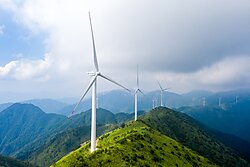-
It is conventional wisdom that adding billions of people to the global economy must result in increased use and therefore greater scarcity of resources, but that is wrong.
-
Resources have become significantly cheaper since 1980 relative to wages, thereby becoming much more abundant.
-
Humans, especially those living in countries on the frontier of innovation, create new knowledge that allows us to grow our resources well beyond our consumption.
-
Globalization allows this new knowledge to flow from the countries on the frontier of innovation to the “catch-up” nations, leading to improved economic and environmental outcomes worldwide.
Introduction
Common sense dictates that adding billions of people to the global economy—and the subsequent rise in production and consumption—must result in increased use and, therefore, greater scarcity of resources. Many of the academic and nonacademic opinions agree on that point, but they are all mistaken. Relative to wages, resources have grown significantly cheaper since 1980, thereby becoming much more abundant. We thus face a seeming contradiction: the more resources we use, the more we end up with. Resolving that requires us to understand the key role played by the creation of knowledge.
Knowledge possesses a peculiar characteristic: the more knowledge we consume, the more knowledge we have. Furthermore, generation of new knowledge is the exclusive domain of the human mind. So, the more people who inhabit the planet and partake in global exchange, the more knowledge is created. This new knowledge, in turn, expands our resource base. Globalization—or the process of interaction and integration between people and companies worldwide—supercharges the process of knowledge creation and knowledge dissemination, thereby leading to greater resource abundance.
Empirical Evidence for Falling Resource Prices
The Simon Abundance Index, which I coauthored with Gale L. Pooley, is an annual measure of the relationship between population growth and the abundance of 50 basic commodities, including food, energy, materials, minerals, and metals. The base year of the index is 1980, and the base value of the index is 100. In 2020, the index reached 708.4. In other words, the index rose by 608.4 percentage points over the preceding four decades, implying a compound annual growth rate in resource abundance of around 5 percent and a doubling of global resource abundance every 14 years or so.
The Simon Abundance Index is measured in time prices, or the number of hours that the average worker must work to earn enough money to buy something. To calculate a commodity’s time price, the nominal price of a commodity is divided by the global average nominal wage per hour worked. Between 1980 and 2020, the average nominal price of the 50 commodities rose by 51.9 percent and the global average nominal hourly wage rose by 412.4 percent. So the average time price of the 50 commodities fell by 75.2 percent.
The personal resource abundance multiplier is calculated by dividing the average time price of the 50 commodities in 1980 by the average time price of the 50 commodities in 2020. The multiplier tells us how much more of a resource a person can buy for the same hours of work between two points in time. Pooley and I found that the same hours of work bought one unit in the basket of 50 commodities in 1980 and 4.03 units in the same basket in 2020.
The average worker’s personal resource abundance rose by 303 percent. The compound annual growth rate in personal resource abundance amounted to 3.55 percent, implying that personal resource abundance doubled every 20 years.
Between 1980 and 2020, the average time price of the 50 commodities fell by 75.2 percent and the world’s population increased by 75.8 percent. So, for every 1 percent increase in the world’s population, the average time price of the 50 commodities decreased by almost 1 percent (i.e., −75.2 percent ÷ 75.8 percent = −0.992 percent).
Note that the personal resource abundance analysis looks at resource abundance from the perspective of an individual human being. The question we aim to answer is: How much more abundant have resources become for the average worker?
Population resource abundance analysis, in contrast, allows us to quantify the relationship between global resource abundance and global population growth. You can think of the difference between the two levels of analysis by using a pizza analogy. Personal resource abundance measures the size of a slice of pizza per person. Population resource abundance measures the size of the entire pizza pie.
The population resource abundance multiplier is calculated by multiplying the change in personal resource abundance with the change in global population (i.e., 4.03 × 1.758). The multiplier of 7.08 corresponds to the 708.4 value in the Simon Abundance Index. It indicates an increase in the global resource abundance of 608.4 percent at a compound annual growth rate of around 5 percent. As such, Pooley and I estimate that global resource abundance doubled every 14 years or so.
Finally, let us look at the resource abundance elasticity of population. In economics, elasticity measures one variable’s sensitivity to a change in another variable. If variable x changes by 10 percent, while variable y, because of the change in x, changes by 5 percent, then the elasticity coefficient of x relative to y is 2.0 (i.e., 10 ÷ 5). A coefficient of 2.0 can be interpreted as a 2 percent change in x corresponding to a 1 percent change in y.
Pooley and I found that every 1 percent increase in population corresponded to an increase in personal resource abundance (i.e., the size of the slice of pizza) of 4 percent (i.e., 303 ÷ 75.8). We also found that every 1 percent increase in population corresponded to an increase in population resource abundance (i.e., the size of the pizza pie) of 8.03 percent (608.5 ÷ 75.8).
Knowledge Creation and Resource Expansion
There are several ways in which humans can make resources more abundant. To start, consider the increase of supply. When the price of a commodity increases, people have a monetary incentive to start searching for new sources of that commodity. For example, when the price of petroleum increases, people will look for more oil deposits. Thus, after a century of petroleum use, we have more known reserves of oil than ever before. Moreover, much of the Earth’s crust, not to mention the ocean floor, remains unexplored. The potential for finding much more petroleum when the price of oil is high enough to induce us to dig deeper and explore more exotic locations is very high. The supply of petroleum can also be increased through technological change. Many of the oil fields that were previously deemed exhausted still contain a great deal of oil trapped in underground shale rock. Replacing conventional oil drilling with hydraulic fracturing allows us to get at that oil in an economical way.
Increased efficiency is also important. Efficiency can increase in relative and absolute ways. For example, when the Coca-Cola can first appeared on the market in the late 1950s, it contained three ounces of aluminum. Today, it contains half an ounce. Of course, it is possible to decrease the amount of aluminum in each soda can while producing so many cans that the absolute amount of aluminum used increases. Remarkably, Andrew McAfee from the Massachusetts Institute of Technology found that the total amount of resources used by the US economy peaked in the first decade of the new millennium and then started to decline. To be precise, 66 out of 72 resources tracked by the US Geological Survey were “post-peak” when McAfee wrote his book More from Less in 2019. In the meantime, the US economy continued to expand. Similar trends could be observed in the United Kingdom and some other advanced economies.
Dematerialization helps to explain why economic growth and resource use reduction can go hand in hand. Most readers will be familiar with thick blue copper cables that ran from the walls of most hotel rooms in the United States until recently. That cable enabled hotel guests to access the internet—a task that can now be accomplished via Wi-Fi. No cables are necessary, and all that saved copper can be used somewhere else. The iPhone is another example of dematerialization, for it replaces (or substantially decreases the need for) calculators, satellite navigation, watches, torches, radios, compasses, cameras, postal mail, telephones, voice recorders, stereos, alarm clocks, and many other things. In addition to the materials not used in the process of making an iPhone, we must also add the energy not used in the mining of the resources that are no longer needed and in the running of all the separate devices that the iPhone replaces.
New knowledge can also help us create ever more value from the same resource. Around 5,000 years ago, someone in Mesopotamia noticed that when sand is heated to 3,090 degrees Fahrenheit, it melts and turns to glass. Our distant ancestors’ first use of glass was for decorative purposes, such as glass beads. Sometime later, they started to use sand to make glass jars, cups, and, later still, windows. Today, we use glass in fiberoptic cables and microchips. With every step of the way, the value we derived from a grain of sand increased, and no one knows what marvelous innovations will rely on sand in the future. The US economist Thomas Sowell is thus surely correct to observe that “the cavemen had the same natural resources at their disposal as we have today, and the difference between their standard of living and ours is a difference between the knowledge they could bring to bear on those resources and the knowledge used today.”
Consider also our ability to turn a previously useless or even harmful resource to our benefit. In the early 20th century, when oil was the primary target of drilling operations, natural gas was often seen as a byproduct with little or no economic value. As such, gas was frequently vented into the atmosphere or flared (burned off), which was wasteful and environmentally harmful. Moreover, natural gas leaks were a significant hazard, particularly in oil fields, where accidental ignitions could lead to explosions. Today in advanced economies, we have the technology to capture, transport, sell, and use gas in great volumes, thereby increasing our resource base and reducing our carbon dioxide emissions into the atmosphere.
Substitution is a crucial economic concept that’s much underappreciated by the public. Generally, we don’t care how we obtain a good or a service, so long as we get it at an acceptable cost. Thus, humans felled forests to get the wood they needed to heat their homes and slaughtered whales to get the lamp oil for illumination. Today, many of us heat and light our homes using electricity derived from a variety of sources, including mostly carbon-dioxide-free nuclear fission, with the added benefit that both forests and whales have rebounded. Those concerned about resources that are currently in high demand (such as lithium, which is needed to make batteries for electric vehicles) should take substitution into account. No one knows what resources will be needed to make batteries in 50—let alone 100—years’ time. But new technology-driven surprises are almost guaranteed.
We can also recycle and reuse our resources. The aforementioned copper internet cables, for example, were almost certainly recycled and turned into something else—perhaps copper pipes used in residential plumbing. The 14,000 tons of US government silver, which was used in electromagnets needed by the Manhattan Project to make atomic bombs, was similarly recovered after the end of World War II and added to the stock of precious metals that propped up the value of the US dollar. The point is that atoms of copper, silver, zinc, and much else are only temporarily assigned to perform a certain task. If necessary, they can be extracted and reassigned to make or do something else.
While humans have explored only a tiny fraction of our planet, it is theoretically possible that at some point in the distant future we could encounter an acute shortage of a resource, such as the very rare rhodium, which is currently used in catalytic converters. Let us further assume that the limits on the natural supply of that metal cannot be overcome via increased efficiency, dematerialization, substitution, recycling, or anything else.
In such a case, our descendants could turn to transmutation. Transmutation, which was once a province of alchemy, became real in 1919 when scientists turned nitrogen into oxygen. According to an article I coauthored with University of Oxford physicist David Deutsch, “Today, transmutation is everywhere. The smoke detectors in our homes, for example, contain americium—a manmade radioactive metal produced by plutonium’s absorption of neutrons in nuclear reactors. Specialists transmuted lead into gold many years ago—though the process is currently uneconomical, for it requires far too much energy to replace mining.”
The key to transmutation, then, is plentiful, reliable, supercheap energy, which could be provided by, for example, future fusion reactors. Lest we forget, it was via fusion (nucleosynthesis, to be precise) that many of the elements we use on Earth were created in the first place. Incredibly high temperatures and pressures inside different stars transformed lighter elements into heavier ones, and the heavier elements dispersed throughout the universe after supernovae. Some of those elements eventually helped to form our planet and can be mined in Earth’s crust.
By the time humanity needs to resort to such sophisticated measures to increase our resource base, we may well be a spacefaring civilization, mining the asteroid belt between Mars and Jupiter by ourselves or with the help of AI robots. The belt is rich in resources, including water. Water, which covers 71 percent of our planet, is key, for it contains hydrogen, which also happens to be the most common element in the universe. The Big Bang only created the lightest elements, primarily hydrogen. All other elements are derived from those. A combination of hydrogen and fusion, therefore, could allow us to create everything else we need de novo—indefinitely.
Globalization, the Spread of Knowledge, and Resource Creation
In the 2021 edition of the Simon Abundance Index, Pooley and I found that the time price of wheat fell by 76.1 percent between 1980 and 2020. That means that for the same number of hours of work that would have bought our worker a pound of wheat in 1980, he or she could have bought 4.18 pounds of wheat in 2020. Resource abundance of the worker rose by 318 percent, growing at a compounded annual rate of 3.64 percent, thereby doubling every 19.4 years. (The COVID-19 pandemic and the Russian war on Ukraine affected these numbers negatively, yet Pooley and I found that the trend still holds in the 2024 edition of the index.)
Over the same period (1980–2020), the world’s population rose from 4.44 billion to 7.82 billion, or by 76 percent. Put differently, for every 1 percent increase in global population, the time price of wheat fell by 1 percent. In addition to population growth, the latest round of globalization, which is generally taken to have started in 1980, added billions of new workers to the global economic exchange. These factors contributed to a massive increase in resource consumption and output not only in the countries on the frontier of innovation, such as the United States and those in Western Europe, but also in the “catch-up” countries, such as Bangladesh, Brazil, China, India, Vietnam, and the nations of the former Eastern bloc. Personal incomes and consumption rose.
Yet wheat, a staple eaten all over the world, became much more abundant. Here the salutary effects of globalization are easily discernible because several Western companies have been at the forefront of the agricultural revolution that provided technologies, seeds, and farming practices that enhanced wheat productivity in the catch-up countries. Consider some real-life examples:
- Syngenta’s disease-resistant wheat varieties. Syngenta, a global agribusiness company headquartered in Switzerland, has developed wheat varieties that are resistant to common diseases and pests. For instance, in parts of Africa and Asia, Syngenta’s disease-resistant wheat varieties have helped farmers combat issues such as wheat rust, a major threat to wheat crops. These varieties have not only increased yields per acre of land but also ensured more stable wheat production.
- John Deere’s advanced agricultural machinery. American company John Deere is known for its advanced agricultural machinery. The adoption of this machinery in countries such as India and Ethiopia has revolutionized wheat farming. Mechanized tractors, planters, and harvesters have increased the efficiency of planting and harvesting wheat, leading to higher yields and reduced labor costs.
- BASF’s agronomic solutions. German chemical company BASF provides various agronomic solutions, including fertilizers and pesticides, which are crucial in wheat cultivation. For example, in countries such as Mexico and Pakistan, the use of BASF’s fertilizers and pesticides has resulted in better wheat crop health and increased yields by controlling pests and enhancing soil fertility.
- Bayer’s crop science innovations. Bayer, following its acquisition of Monsanto, has become a key player in agricultural technologies. The company’s development of integrated crop solutions, including advanced seed treatments and chemical products, has improved wheat yields. For example, in Brazil and parts of Africa, Bayer’s products have helped farmers grow wheat more efficiently, even under challenging climatic conditions.
- DuPont’s hybrid wheat seeds. DuPont (now part of Corteva Agriscience after a merger with the Dow Chemical Company) has developed hybrid wheat seeds that are tailored to specific climatic and soil conditions. These seeds have been particularly effective in Eastern Europe and parts of Asia, where they have helped boost wheat yields through improved disease resistance and stress tolerance.
- CIMMYT’s collaboration with Western companies. The International Maize and Wheat Improvement Center (CIMMYT), though not a commercial entity, collaborates with Western companies to develop high-yielding wheat varieties. CIMMYT’s work in countries such as Kenya and India, often in partnership with Western agricultural companies, has led to the introduction of wheat varieties that are well-suited to local conditions, resulting in significant yield improvements.
The results of the spread of information and technologies from the countries on the frontier of innovation to the catch-up countries are readily discernible. In 1980, wheat productivity measured in 100 grams per hectare was lower, sometimes substantially, in the catch-up countries relative to the United States and Western Europe. By 2020, some had overtaken the United States, while all of them, including the United States, remained less productive relative to Western Europe. Still, all the selected catch-up countries experienced greater productivity gains than the United States and Western Europe between 1980 and 2020.
Environmental Benefits
The period of globalization saw absolute poverty (the threshold of which is considered to be earning wages of $2.15 or less per day) measured in 2017 dollars adjusted for purchasing power parity decline from 43.8 percent in 1981 to 8.9 percent in 2019. Concomitantly, the calorie supply per person rose from 2,497 in 1981 to 2,928 in 2018, or by 17 percent. In Africa, the world’s poorest continent, the calorie supply per person rose from 2,238 to 2,604, or by 16 percent, over the same period. That’s higher than the Portuguese calorie supply in the early 1960s. This trend is likely going to improve in the future, raising the obvious question: What will happen to the animal and plant habitats as humans strive to produce more food and other resources? The answer is once again counterintuitive.
Writing about US corn production in 2015, Jesse H. Ausubel, an environmental scientist at the Rockefeller University, said, “The average yield of American farmers is nowhere near a ceiling. In 2013, David Hula, a farmer in Virginia, grew a US and probably world record: 454 bushels of corn per acre—three times the average yield in Iowa.… In 2014, Hula’s harvest rose 5 percent higher to 476 bushels, while Randy Dowdy, who farms near Valdosta, Georgia, busted the 500-bushel wall with a yield of 503 bushels per acre and won the National Corn Growers Contest.” And, Ausubel continued, “if we keep lifting average yields toward the demonstrated levels of David Hula and Randy Dowdy … then an area the size of India or of the United States east of the Mississippi could be released globally from agriculture over the next 50 years or so.”
A similar story can also be told of wheat, rice, barley, potatoes, casava, beans, and other crops. There is no obvious limit on our ability to produce ever more staples per hectare, thus returning ever larger chunks of the planet back to nature, except for the generation of knowledge and its dissemination to (and acceptance in) the least developed corners of the world. Whether lab-grown meat can alleviate the environmental footprint of cattle, chicken, and pig farming is still an open question. At present, the knowledge to make lab-grown meat economical does not exist. But knowledge is not stagnant. It grows, and those who are betting against lab-grown meats may yet lose their shirts. Finally, the exploitation of raw materials has grown much cleaner in recent decades, a trend that’s likely to continue as nations develop and, per the environmental Kuznets curve, place greater emphasis on environmental quality.
Conclusion
Humans, especially those living in the countries on the frontier of innovation, create knowledge that allows us to grow our resources well in excess of the resources that we consume. Consequently, resources have grown much cheaper relative to wages and, therefore, more abundant. In terms of overall human well-being, however, it is globalization that allows the new knowledge to flow from the countries on the frontier of innovation to the catch-up nations. Finally, the planet and its biosphere benefit as catch-up nations adopt best practices and begin to approximate the care for the environment that’s characteristic of innovative societies.














